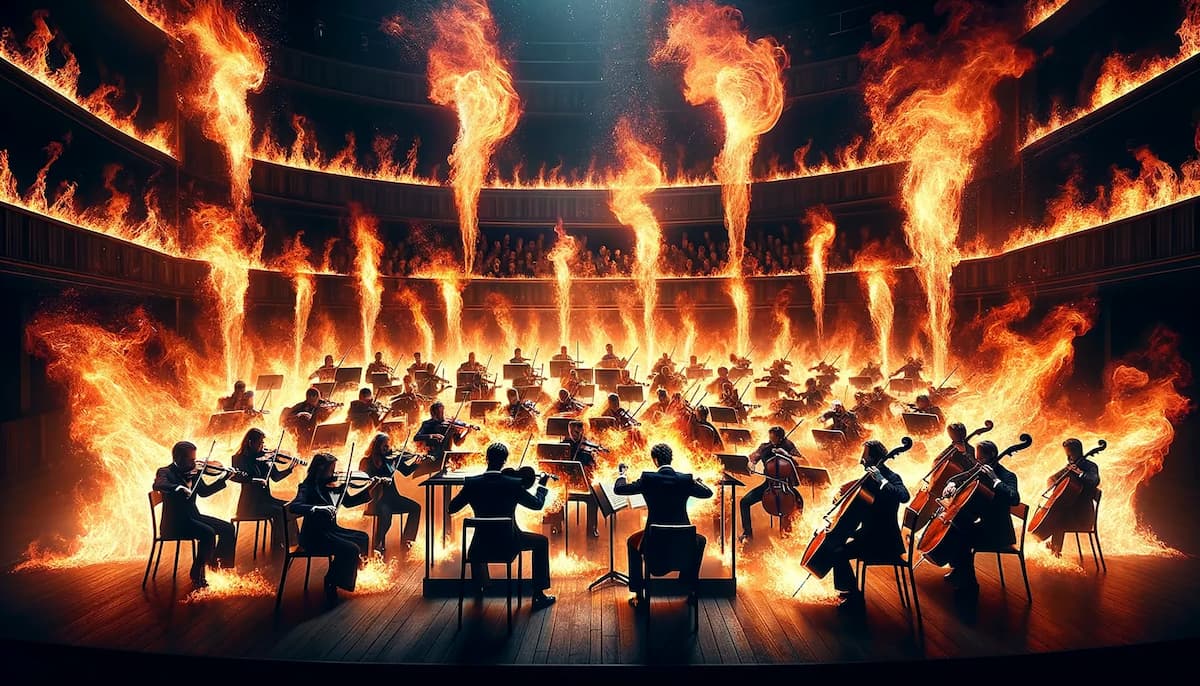Fire has endless contradictory connotations, from the agony of flesh burns to the heat of romantic passion to the comforting domestic warmth of hearth and home. Fire is also a universal symbol of both destruction and renewal.
Maybe that’s why fire has served as such rich inspiration for many classical composers.
Here are sixteen pieces of classical music about fire:

© medium.com
“Fire! Fire!” by Thomas Morley (1595)
Thomas Morley was an English composer, theorist, and contemporary of Shakespeare. He was one of England’s most famous composers in his day, and the brute charm of this madrigal helps explain why.
The delightfully impertinent lyrics describe the burning heat of being in love, amusingly juxtaposing wistful harmonies with energetic nonsense syllables: “Fire, fire! My heart! O, I burn me! Alas! Fa la la la la.”
Later the singers beg any sympathetic listeners: “O…drench me!” followed by another “fa la la la” for good measure.
Symphony No. 59, “Fire” by Joseph Haydn (1768)
Haydn never actually gave this work the nickname “Fire”; that came much later. Apparently it was meant as a reference to the fiery, spritely first movement and brief madcap finale.
However, since so many listeners over the generations have connected this music to fire, we’re including it on this list!
Is Not His Word Like a Fire? from Elijah by Felix Mendelssohn (1846)
Elijah was one of Felix Mendelssohn’s last works. He died the year after it was composed.
Elijah takes inspiration from the Old Testament: more specifically, the story of the prophet Elijah as found in the books of I Kings and II Kings.
In it, Elijah demands of the audience:
Is not His word like a fire,
and like a hammer that breaketh the rock into pieces!
For God is angry with the wicked every day.
And if the wicked turn not, the Lord will whet His sword,
And He hath bent His bow, and made it ready.
You can hear the fury of the flames in the strings’ tremolo (i.e., fast repeated notes).
Magic Fire Music from Die Walküre by Richard Wagner (1870)
At the end of Richard Wagner’s opera Die Walküre, Wotan, the ruler of the gods, takes revenge on his rebellious daughter Brünnhilde, who has run afoul of him while meddling in the affairs of mortals. Brünnhilde’s punishment is to become a mortal woman herself.
Sieglinde, a pregnant woman who Brünnhilde saved, is allowed to survive. However, she will have to enter an enchanted sleep, and be encased behind a barrier of perpetual flame.
“Dies Irae” from the Requiem by Giuseppe Verdi (1874)
Verdi took clear delight in crafting this portion of his stormy Requiem. The words he is setting read in part:
The day of wrath, that day will
dissolve the world in glowing ashes,
as David and the Sibyl prophesied.
How great will be the terror,
when the Judge comes
to give strict justice.
At the Fireside, January, from The Seasons by Pyotr Ilyich Tchaikovsky (1876)
Tchaikovsky had a very different view of fire than Wagner or Verdi. In this context, it becomes a symbol of comfort: content domesticity against the backdrop of a cold Russian winter.
6 Songs, No. 2, Saarella palaa (Fire on the Island), Op. 18 by Jean Sibelius (ca 1898)
Sibelius’s 6 Partsongs were composed between 1898 and 1901.
The 6 Partsongs were originally written for a capella male choir, but Sibelius later rearranged them for mixed choir, too. This brief piece – which means “Fire on the Island” in English – is among them.
Midnight Fire Alarm by Harry J. Lincoln (1900)
American composer Harry J. Lincoln lived between 1878 and 1937. In his day, he was famous for his marches and rags.
This is one particularly exuberant example of his work. It makes a gleeful spectacle out of a nighttime fire alarm. This later orchestration includes wails that call to mind early hand-cranked sirens.
The Roadside Fire from Songs of Travel by Ralph Vaughan Williams (1901-1904)
Between 1901 and 1904, English composer Ralph Vaughan Williams set poetry from Robert Louis Stevenson’s book of poetry, Songs of Travel.
In the poem The Roadside Fire, the exuberant narrator describes with relish the small, domestic moments of a great love. He decrees that he will craft homemade gifts for his beloved, and that they will spend time together in nature and on the road. These moments spent alone will be precious to them both.
Vaughan Williams captures both the excitement and coziness of these ideas perfectly in his music.
The Origin of Fire by Jean Sibelius (1902)
When composing The Origin of Fire, Jean Sibelius turned to a familiar work: the Kalevala, Finland’s national epic.
The lyrics speak of a time when the Mistress of Pohjola has stolen the sun, moon, and fire. The land of Ukko, the god of the sky, became unbearably dark and dreary.
Eventually Ukko loses patience with the darkness. So he creates fire from his sword, “flames that were bright as the lightning.”
He keeps the spark safe in a golden casket until it grows enough to become a new sun. A maiden is tasked with rocking the spark’s casket. But she makes a mistake and the light escapes.
The Firebird by Igor Stravinsky (1910)
The story of the Firebird, a character from Russian folklore, turned into a veritable national myth during the nineteenth century.
The Firebird – a phoenix – is a magical bird with glowing feathers that is famous for its ability to burn to death and then rise again from its own ashes.
In the Stravinsky version of the story, an evil ogre-like creature named Koschei the Deathless abducts young princesses and turns their would-be rescuers into stone.
The ballet’s brave protagonist, Prince Ivan, ignores the danger. He captures the Firebird and enlists it in his fight against Koschei. The Firebird helps by enchanting Koschei, and the ogre dances himself to sleep.
Koschei’s soul lives inside a magic egg, which Ivan then crushes, killing him. Celebration ensues.
Vers la flamme by Alexander Scriabin (1914)
Alexander Scriabin was a famous eccentric. He believed that the world would burn due to an overaccumulation of heat in the atmosphere. (Well, on second thought, maybe he was onto something…)
He depicted this apocalyptic warming in Vers la flamme (“Towards the flame”), a strange, striking piece for solo piano.
Throughout the work, the pianist is constantly searching, employing unusual harmonies, unsettled rhythms, and extreme dynamics.
Those elements all work together to create a tension that pushes the listener further and further into the unknown.
Ritual Fire Dance by Manuel de Falla (1915)
The story behind the Ritual Fire Dance is a doozy.
A young Andalusian widow named Candela is being haunted by her dead husband. So she decides to do the one thing that will cleanse herself of her past: a ritual fire dance.
At midnight her entire camp surrounds a fire, and Candela begins to dance.
Sure enough, her ghostly husband soon appears. However, even across dimensions, they remain at loggerheads. So Candela dances faster and faster until finally she whirls the apparition into the flames. She is free at last.
Dance of Spirits of Fire from The Perfect Fool by Gustav Holst (1918-1922)
Immediately after World War I, English composer Gustav Holst wrote an opera called The Perfect Fool. It began with a ballet.
In this ballet, a wizard summons spirits from three realms: the realm of Earth, the realm of Water, and the realm of Fire.
During the Dance of Spirits of Fire, a listener can imagine flames roaring toward the sky, with cymbal crashes calling to mind flying sparks.
Novorovsky Chimes – The Fire of Eternal Glory by Dmitri Shostakovich (1960)
Officially, this somber, majestic little piece was written in 1960.
However, the meat of the music dates back to the early 1940s, when Shostakovich entered a concert to determine a new Soviet national anthem.
Its later incarnation came after the war monument known as Heroes Square was dedicated in 1960.
The piece has been playing there nonstop ever since: a musical version of the Eternal Flame.
The Burning Fiery Furnace by Benjamin Britten (1966)
Britten’s The Burning Fiery Furnace borrows its plot from the Old Testament story of Shadrach, Meshach, and Abednego, found in the book of Daniel.
In that story, the three Israelite men are thrown into a furnace as punishment by Babylonian king Nebuchadnezzar II, because they will not worship a golden image of the king.
However, the men are protected by God and survive. Not only that, but not a hair on their heads is singed. As if that weren’t unnerving enough, the king sees a fourth man in the furnace: the Son of God, maybe?
Britten uses a unique format to tell this story. The Burning Fiery Furnace is not so much an opera as it is a musical drama with singing.
Conclusion
We hope you enjoyed this tour of sixteen pieces of classical music associated with fire!
We hope this playlist lights a fire under you (ba-dum-tss) to search out even more. There’s always more to discover in the world of classical music.
Happy listening!
For more of the best in classical music, sign up for our E-Newsletter

